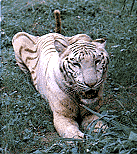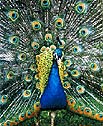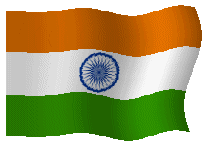|
THE NATIONAL ANTHEM OF INDIA
Jana-Gana-Mana
The Indian National anthem,
composed originally in Bengali by Rabindranath Tagore, was adopted in its
Hindi version by the Constituent Assembly as the National Anthem of India
on 24 January 1950. It was first sung 27 December 1911 at the Calcutta
session of the Indian National Congress. The complete song consists of
five stanzas. The lyrics were rendered into English by Tagore
himself.
THE NATIONAL ANTHEM
" Jana Gana Mana Adhinayaka Jaya He
Bharat Bhagya Vidhata
Punjab Sindh Gujarat Maratha
Dravida Utkala Banga
Vindhya Himachal Yamuna Ganga
Ucchala Jaladhi Taranga
Tubh Shubha Name Jage
Tubh Shubha Ashisha Mange
Gahe Tubh Jaya Gata
Jan Gan Mangaldayak Jay He
Bharat Bhagya Vidhata
Jaye He ! Jaye He ! Jaye He !
Jaye,Jaye,Jaye,Jaye He "
|
Translation of The national anthem- Jana Gana Mana In
English
Thou are the ruler
of the minds of all people, dispenser of India's
destiny.
The name rouses the
hearts of Punjab, Sind, Gujurat and Maratha. Of the Dravid and
Orissa and Bengal.
It Echoes in the
hills of Vindhyas and Himalayas, mingles in the music of Yamuna and
Ganga and is chanted by the waves of the Indian Sea.
They pray for your
blessing and sing thy praise. The salvation of all peaople is thy
hand, thou dispenser of India's destiny. Victory, Victory, Victory
to thee.
The Jana Gana Mana was composed
by Shri Rabindranath Tagore
and first sung at the Calcutta session of the Indian National
Congress on December 27th, 1911. It was adopted as the National
Anthem of India on 24th January, 1950 by the Constituent Assembly.
The first stanza( out of five stanzas) of the song forms the
National Anthem.

Bharatma |
|
FLAG OF INDIA
THE NATIONAL FLAG OF INDIA is in tricolour of
deep saffron(Kesari) at the top, white in the middle and dark green
at the bottom in equal propotions.The flag is a horizontal tricolour
in equal proportion of deep saffron on the top, white in the middle
and dark green at the bottom. The ratio of the width to the length
of the flag is two is to three. In the centre of the white band,
there is a wheel in navy blue to indicate the Dharma Chakra, the
wheel of law in the Sarnath Lion Capital. Its diameter approximates
the width of the white band and it has 24 spokes. The saffron stands
for courage, sacrifice and the spirit of renunciation; the white,
for purity and truth; the green for faith and fertility. The design
of the National Flag was adopted by India's constituent assembly on
22nd july, 1947. It's use and display are regulated by a code. The
Indian flag symbolizes freedom. The late Prime Minister Pandit Nehru
called it a flag not only of freedom for ourselves, but a symbol of
freedom for all people.
|
| Some interesting flag facts :
Our national flag was hoisted on
Mt. Everest, the highest peak in the world, on May 29 1953,
along with the Union Jack and the Nepalese National
flag. In 1971, the Indian flag, went into space on board
Apollo-15. It flew into space as a medallion on the spacesuit
worn by Cosmonaut Wing Commander Rakesh Sharma, during the
Indo-Soviet joint space flight in April 1984. On January 9
1982, the first Indian Antarctica Expedition planted the first
Indian flag over Dakshin Gangotri. It was hoisted for the
first time on the South Pole on January 17, 1989, by Colonel
J.K. Bajaj. On April 21, 1996, at 0352 hrs (IST), the first
Indian and perhaps the first in Asia, Sqdn. Ldr. Sanjay
Thapar, holder of many national and international records in
parajumping and skydiving, jumped from an altitude of 10,000
ft from an MI - 8 helicopter and hoisted the Indian tricolour
on the North Pole. On Sept 28, 1985, the Tiranga set out on an
around the world sailing expedition on board Trishna under
Colonel T.P.S. Chowdhry and successfully returned home on
January 10, 1987, cruising the high seas of the world and
covering over 30,000 nautical miles in 470
days.
|
|
|
National Emblem of India

The National emblem is a symbol of
contemporary India's reaffirmation of its commitment to world peace and
goodwill.
The National Emblem of India is a replica of
the Lion of Sarnath, near Varanasi in Uttar Pradesh State. The Lion
Capital was erected in the 3rd century BC by Emperor Ashoka to mark the
spot where Lord Buddha first proclaimed his gospel of peace and
emancipation..
It is symbolic of India's reaffirmation of its
ancient commitment to world peace and goodwill. In the original, there are
four lions, standing back to back, mounted on a abacus with a frieze
carrying sculptures in high relief of an elephant, a galloping horse, a
bull and a lion separated by intervening wheels over a bell-shaped lotus.
Carved out of a single block of polished sandstone, the capital is crowned
by the Wheel of the Law (Dharma Chakra).
In the
state emblem adopted by the Government of India on 26 January 1950, only
three lions are visible, the fourth being hidden from view. The wheel
appears in relief in the center of the abacus with a bull on the right and
a horse on the left and the outlines of the other wheels on extreme right
and left. The bell-shaped lotus has been omitted.
The four lions (one hidden from view) -
symbolising power, courage and confidence - rest on a circular abacus. The
abacus is girded by four smaller animals - guardians of the four
directions: the lion of the north, the elephant of the east, the horse of
the south and the bull of the west.The abacus rests on a lotus in full
bloom, exemplifying the fountainhead of life and creative inspiration. The
motto 'Satyameva Jayate' inscribed below the emblem in Devanagari script
means 'truth alone triumphs'
|
|
National Animal of India THE
TIGER .

The magnificent Tiger Panthera tigris (linnaeus), the
national animal of India, is a rich-colored well-striped animal with a
short coat. The combination of grace, strength, power has earned the tiger
great respect and high esteem. Indian tigers are famous all over the world
and one of the main attractions for the lovers of wild life. They are the
crowning glory and the light of the Indian wild life.
Tough,
muscular, majestic tigers roam about the Sunderbans of Bengal "burning
bright in the darkness of the night." The natives of the forest worship
the tiger as the deity that gives them honey and wax. The Sunderbans are
their main habitat for their thick forests of Sunder trees. They feed on
fish, cattle and sometimes human beings. The man-eaters are the most
dreaded of all wild beasts. It is a common belief that a tiger does not
harm anyone who has offered prayers to him. Tigers are fast runners,
excellent swimmers and their eyesight is strong.
To check
the dwindling population of tigers in India, which came down to just 1,827
in 1972, massive conservation program was initiated in April 1973, known
as the 'Project Tiger'. This project aims to maintain a viable population
of tigers in India for scientific, economic, aesthetic, cultural and
ecological values. Since then, the tiger population has shown a gradual
increase and the census of 1989 puts the tiger population of the country
at 4,334. So far, 19 tiger reserves have been established in the country
under this project, covering over 29, 716 sq. km. forest
area |
|
National Bird of India THE
PEACOCK

Peacock is a large and majestic bird. It has
got a long and beautiful tail. Both the peacock and the hen have crest.
But the crest of hen is smaller in size. The main body of the cock is
mottled brown in color. Especially, the metallic green color found on the
lower neck is very attractive. Though peacocks are beautiful looking birds
their calls are loud and coarse.
They move
in-groups and they are normally spotted in the forests, villages and
nearby fields. They are shy in nature. It feeds on lizards, snakes, grains
and insects. The hen lays a maximum of five eggs, which are in pale cream
color.
The
significance of peacock is attached to cultures of India, Far East,
Ancient Persia, Greek and Christian. In Hinduism, the image of the god of
thunder, rains and war, Indra, was depicted in the form of a peacock. In
south India, peacock is considered as a 'vahana' or vehilce of lord
Muruga. The figure of peacock is painted in various Islamic religious
buildings. In Christianity, the peacock was also known as the symbol of
the 'Resurrection'.
In India
people believe that whenever the cock spread its tails in an ornamental
fashion, it indicates that rain is imminent. In a way it is partly true.
At the sight of dark clouds the bird outspreads its tail and starts
dancing in rhythmic fashion. Most of the folklore including Bharatha
Natyam has got special dancing poses for the peacock dance.
|
|
National Flower of India THE
LOTUS

Among the various flowers of Indian
sub-continent, the flower Lotus is regarded with divinity and grace.
Often, Goddesses Lakshmi and Saraswathi are associated with the flower
lotus. Even Lord Siva, who wanted to escape the wrath of the Lord
Saneeswaran, morphed himself into the shape of a bee and took asylum
inside a lotus. Buddhists regard this flower as a sacred one.
Lotus
symbolizes purity, beauty, majesty, grace, fertility, wealth, richness,
knowledge and serenity. They are found in white and pink colors in general
and they grow in shallow and murky waters. Some blue colored flowers are
also sighted. These flowers enjoy a warm sunlight and intolerant to cold
weather. Hence they cannot be seen blossoming in the winter. The floating
leaves and flowers have long stems, which contains air spaces to maintain
buoyancy.
The plant
is having various uniqueness attached to it. Though the large leaves of
the plant are floating on the surface of the water, even a drop of water
is not accommodated on top of the leaves. Perhaps, they are teaching the
human beings, to lead a life of non-attachment and avoid the worldly
pleasures.
Depending
upon the level of water in the tank, the stems will rise. In this fashion,
it is guiding the human beings to rise upto the situation leading to a
genuine elevation in their lives. As the world famous 'Thirukural'
says,
"Vellathanayathu malar neetam
manthartham
ullath thanyathu
ouyarvu"
signifying, in relation with the water level of a tank,
the stem will rise. In the same way, depending upon their ambitions and
thoughts, human beings can elevate themselves in their life.
In Indian
religious epics, references of lotus are made, in relation with eyes and
feet of divine persona. For instance "Kamala Kannan" referring Lord
Krishna with the contextual meaning, a person having eyes with the color
of the pink lotus. Also, it is coupled with the feet of deities. "Kamala
Patham" means lotus feet implying the feet of the god. "Charan Kamala
Patham" implying, submit oneself in totality, at the lotus feet of the
god.
|
|
National
Tree of India THE BANYAN
TREE.

THE BANYAN TREE-Called the Indian
fig tree( Ficus bengalensis) grow over a large area. The roots then
give rise to more trunks and branches. Because of this characteristic
& longevity, the Banyan tree is considered immortal & sacred
and is an integral part of the myths and legends in India. Even today, the
banyan tree is the focal point of village life and the village council
meetings under the shade of this huge shade-giving tree.
|
|
National Fruit of
India THE MANGO

The fruit Mango,of the tree Mangifera
indica, is one of the most widely cultivated fruits of the tropical
world. This juicy, delicious fruit is a rich source of Vitamins A, C and
D. In India there are hundreds of varieties of mangoes, in different
sizes, shapes and colours etc. Mangoes, have been cultivated in India
since time immemorial. The famous Indian poet Kalidasa sang its
praises.King Alexander relished its taste, as did the Chinese traveller
Hieun Tsang. Akbar, the Moghal emperor planted over 100,000 mango trees in
Darbhanga, known as Lakhi Bagh(India).
|
|






